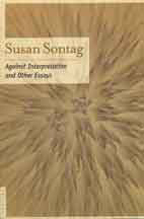 |
Susan Sontag, Against Interpretation and Other Essays. New York: Picador, 2001.
Susan Sontag’s analysis of criticality and her brilliant stand against easily digestible explanations in her 1964 essay “Against Interpretation,” published in this compilation of texts, haunts me. When I write or when I give advice to young critics, I keep in mind her stance that we too often take the visual, and potential for sensory pleasure, for granted, and I often quote her passage that “the function of criticism should be to show how it is what it is, rather than to show what it means.” As we barrel towards a landscape where criticism is in crisis, if not superfluous, the worst crime in arts writing is a sloppy jump to definitive conclusion without grounding opinion in acute observation of the formal mechanisms of how an image, or work of art, operates. Sontag’s call to arms about the important relationship of form of content is inspiring and, still, extremely relevant.
|